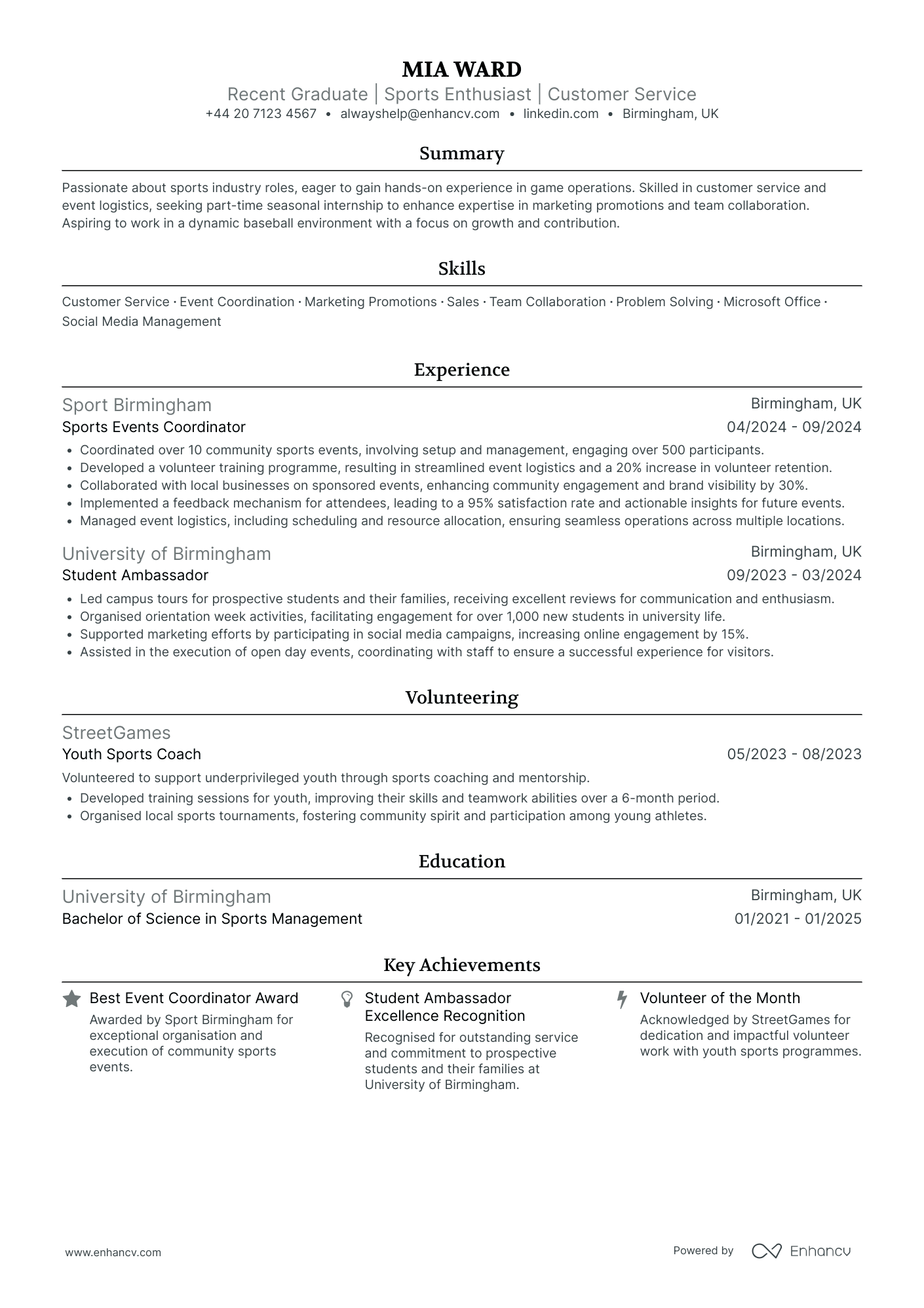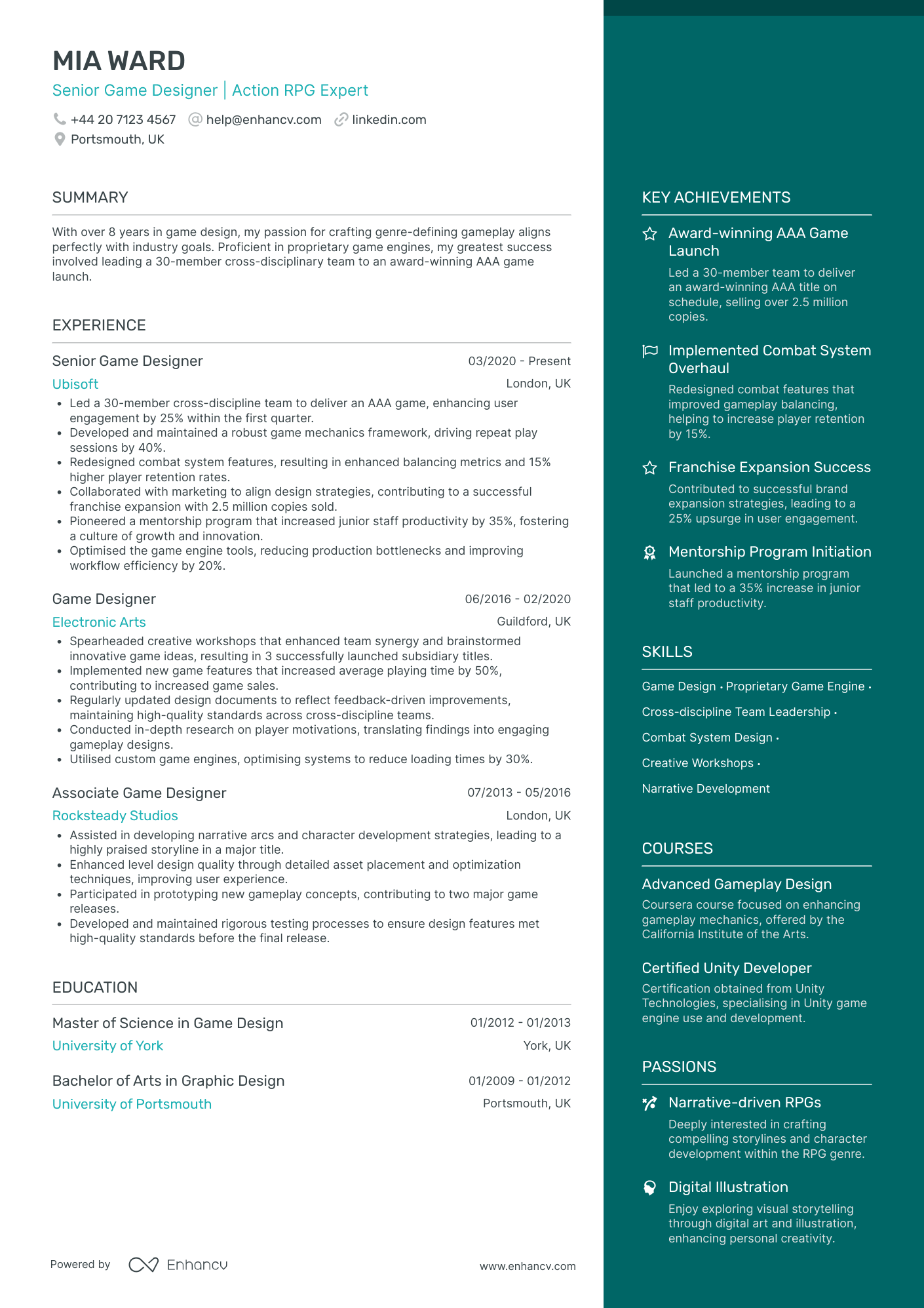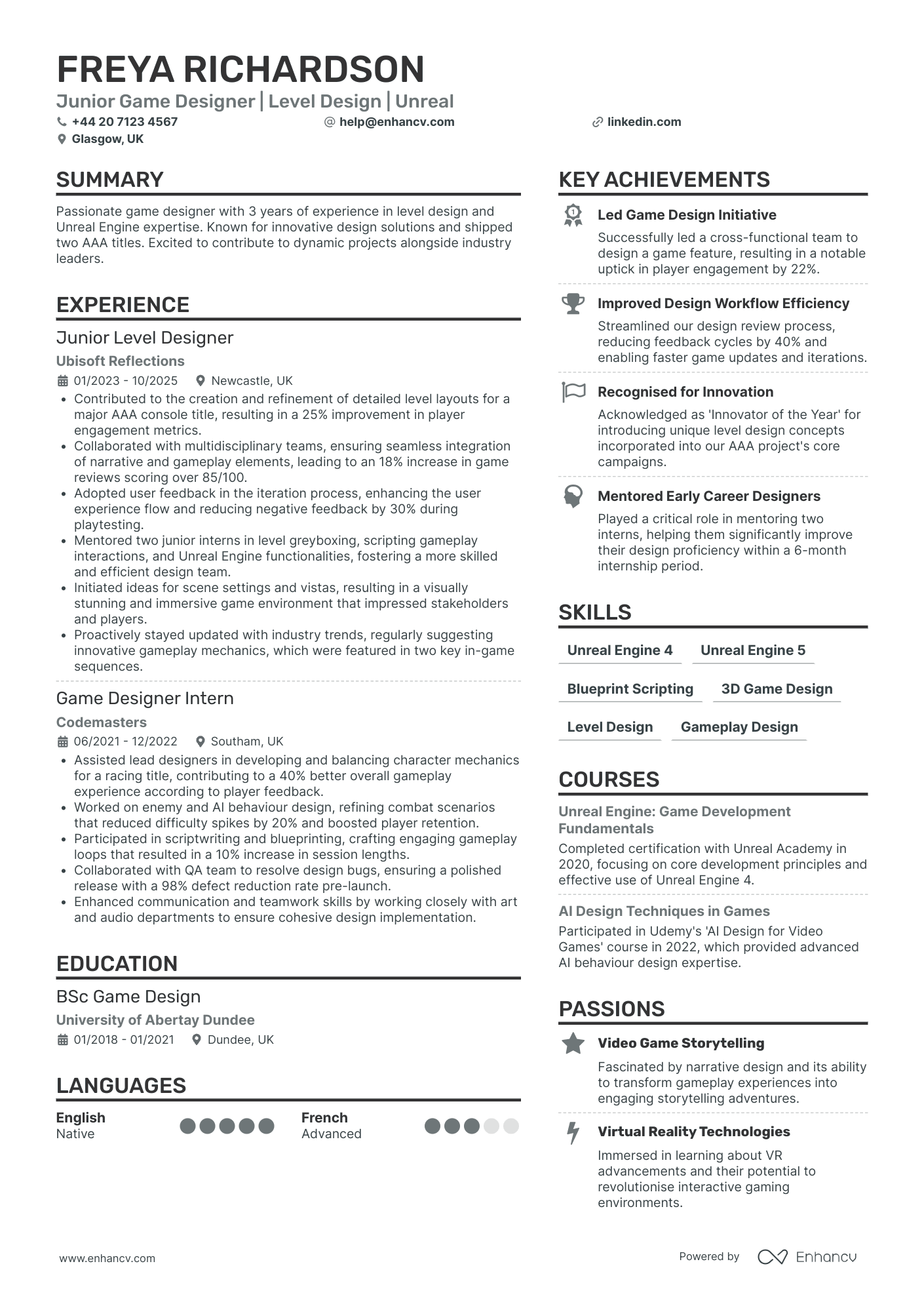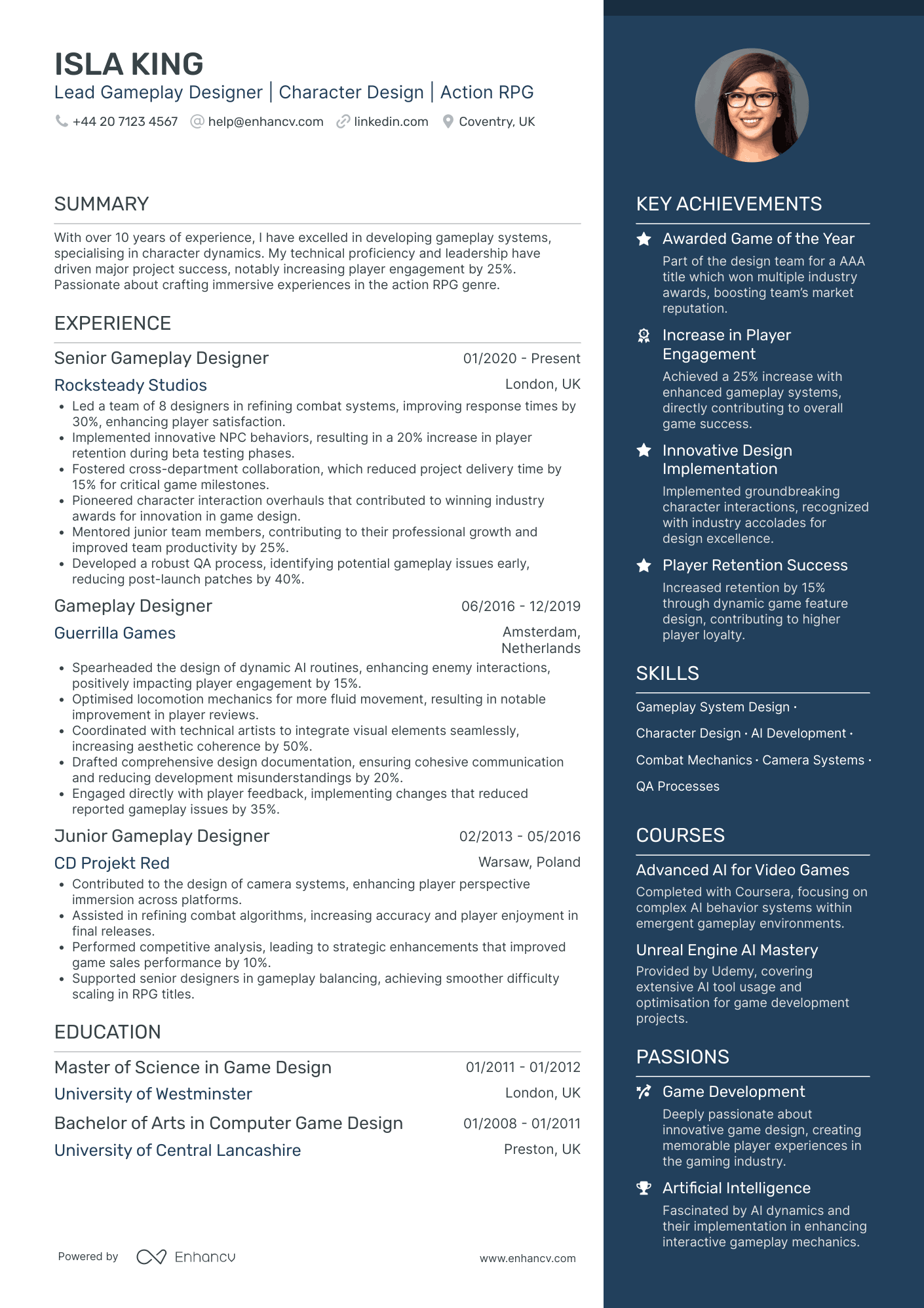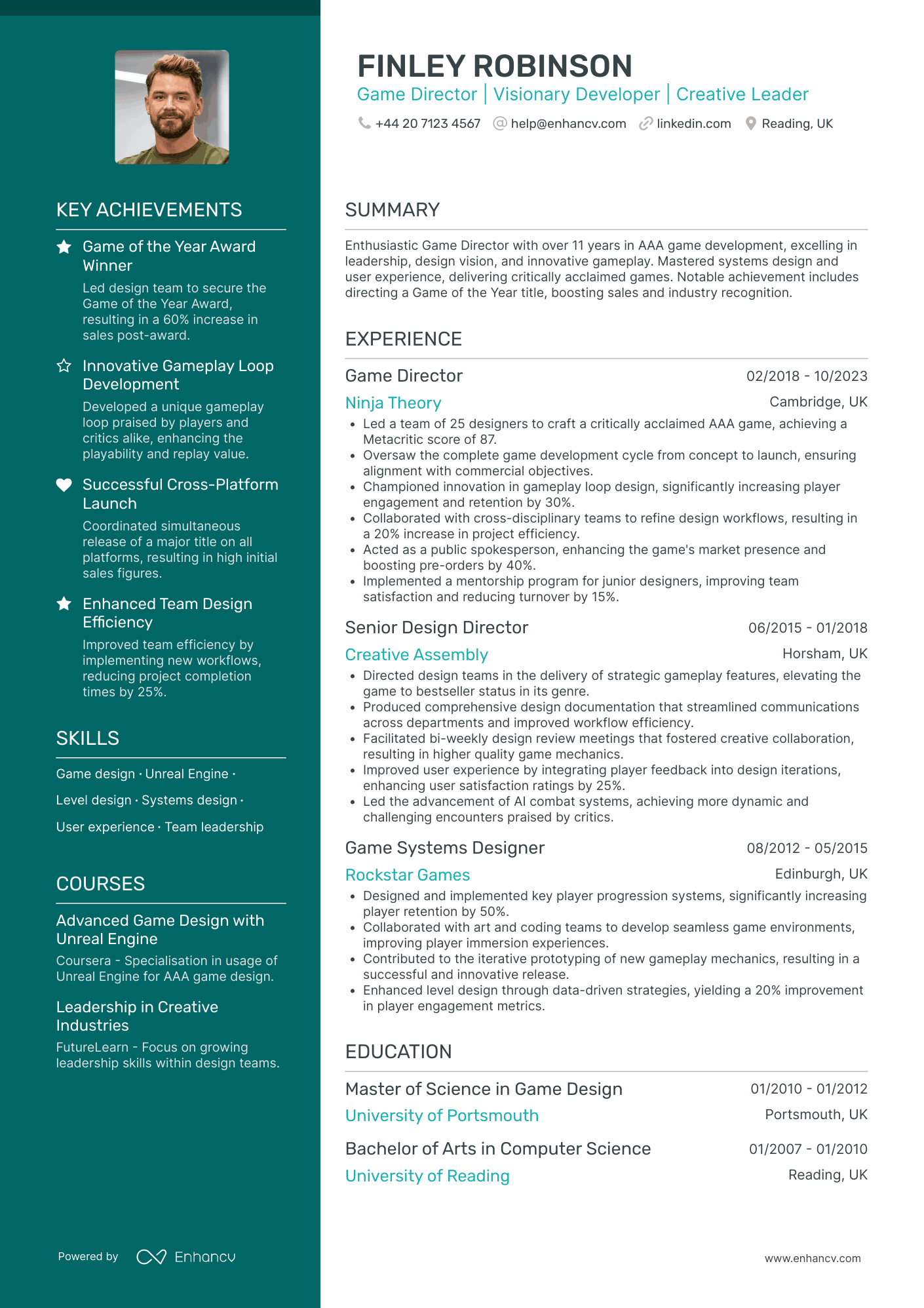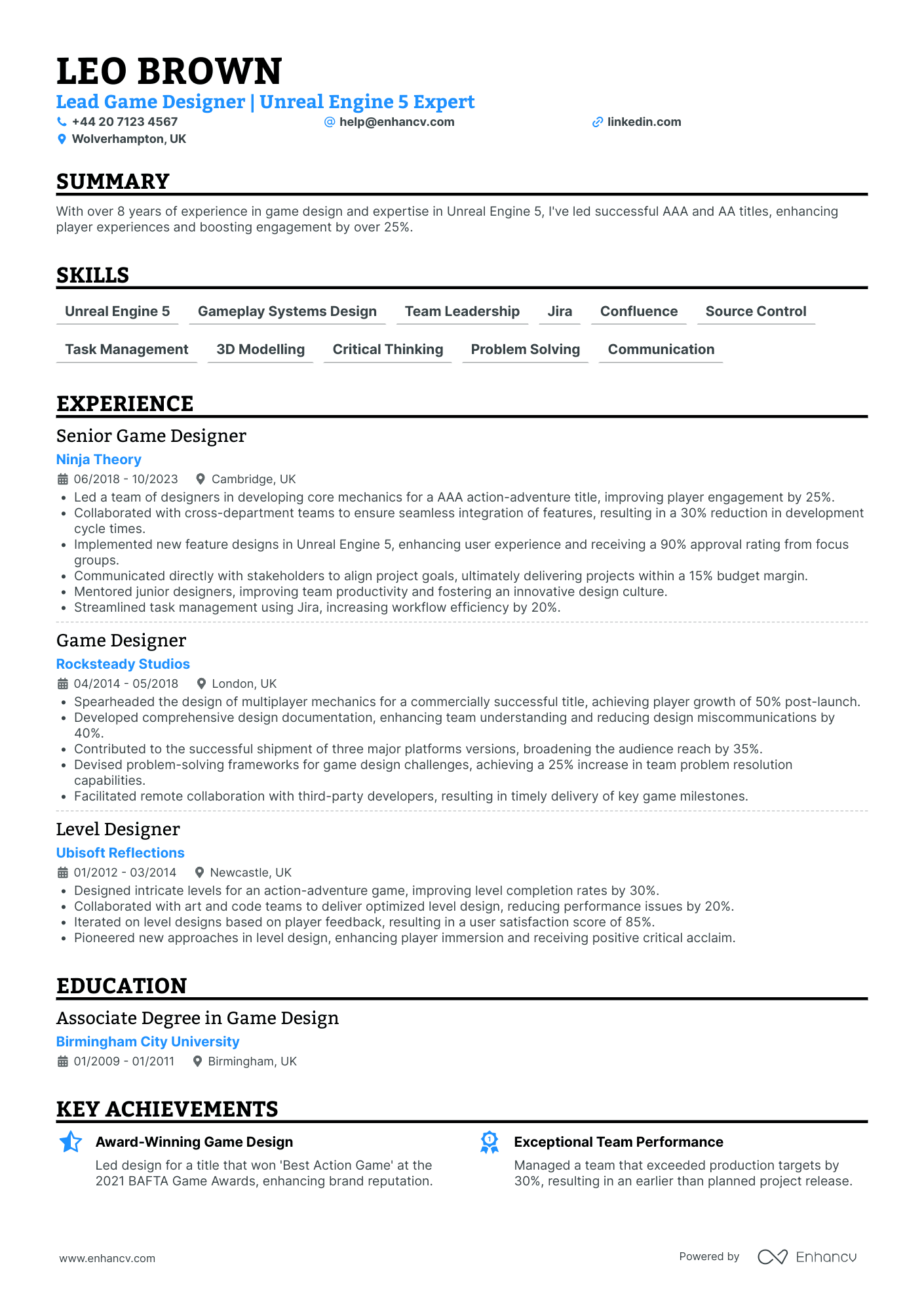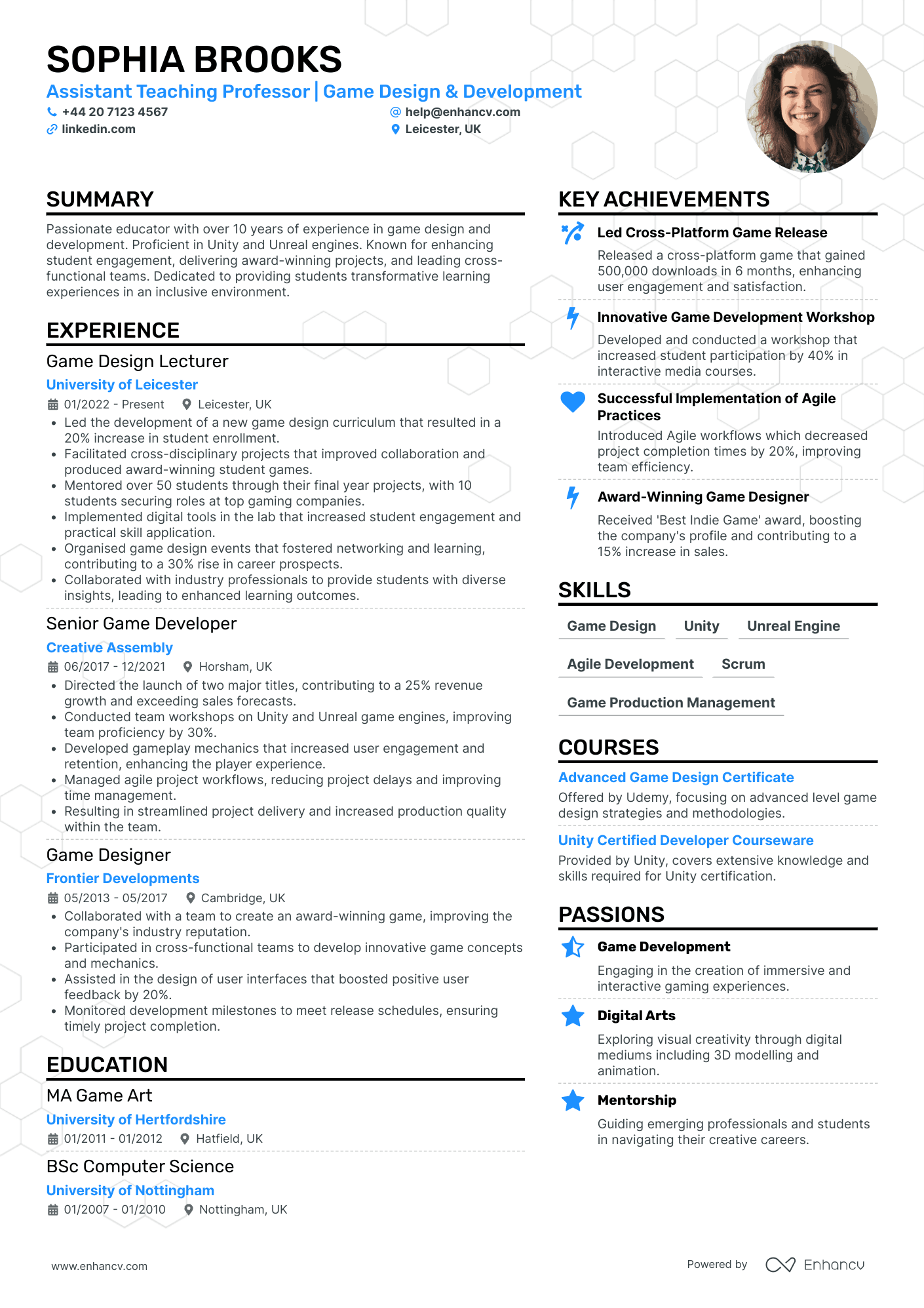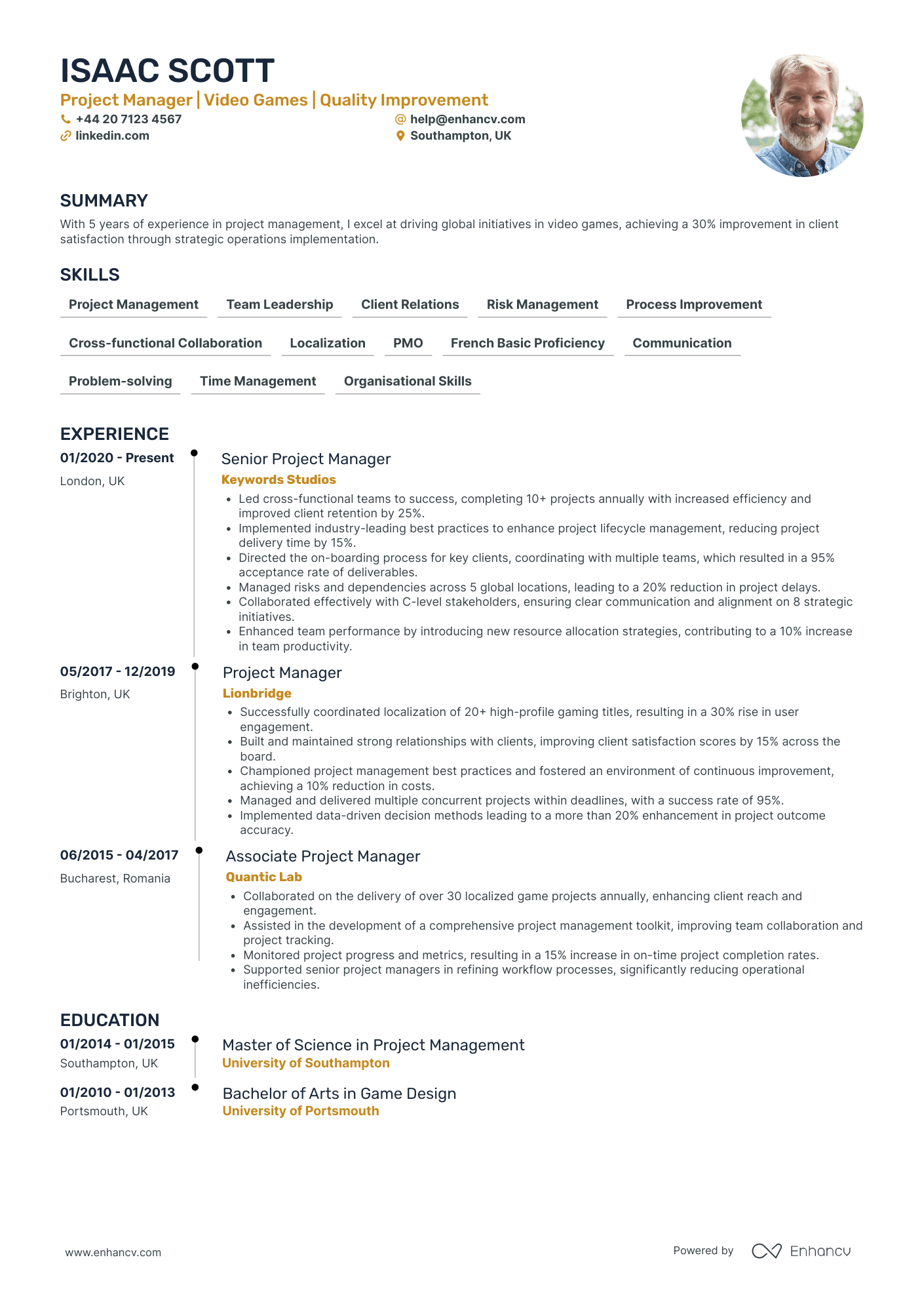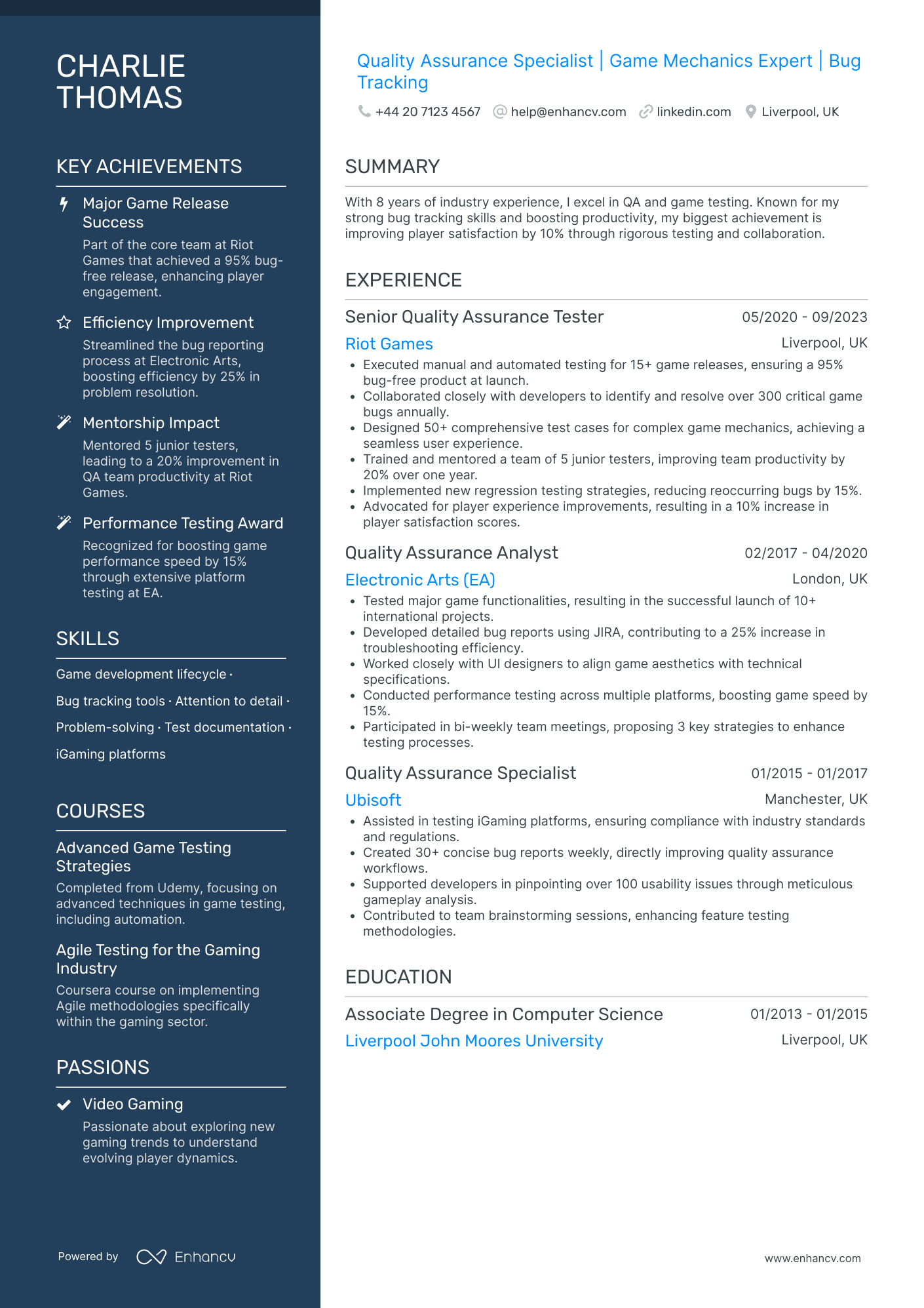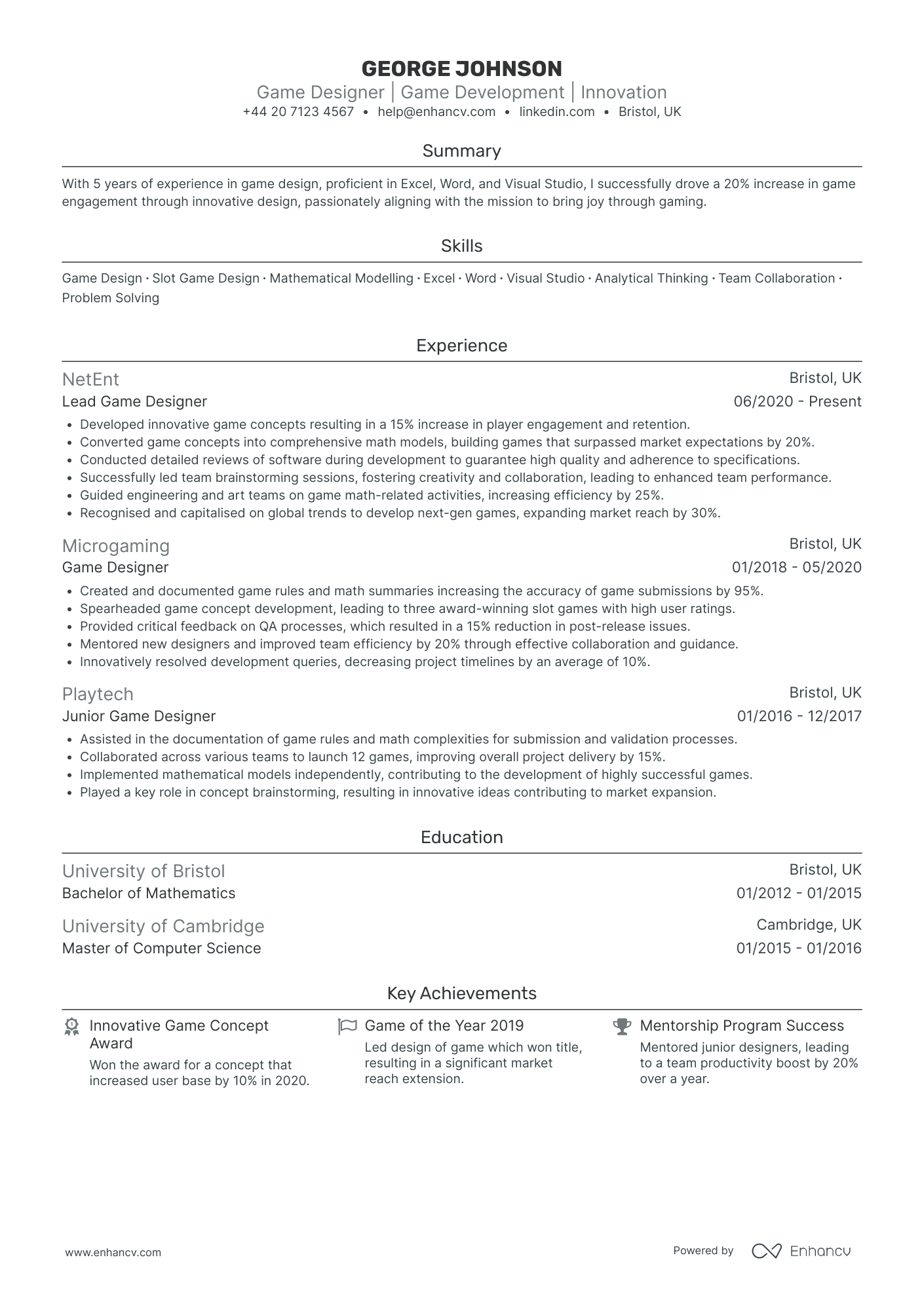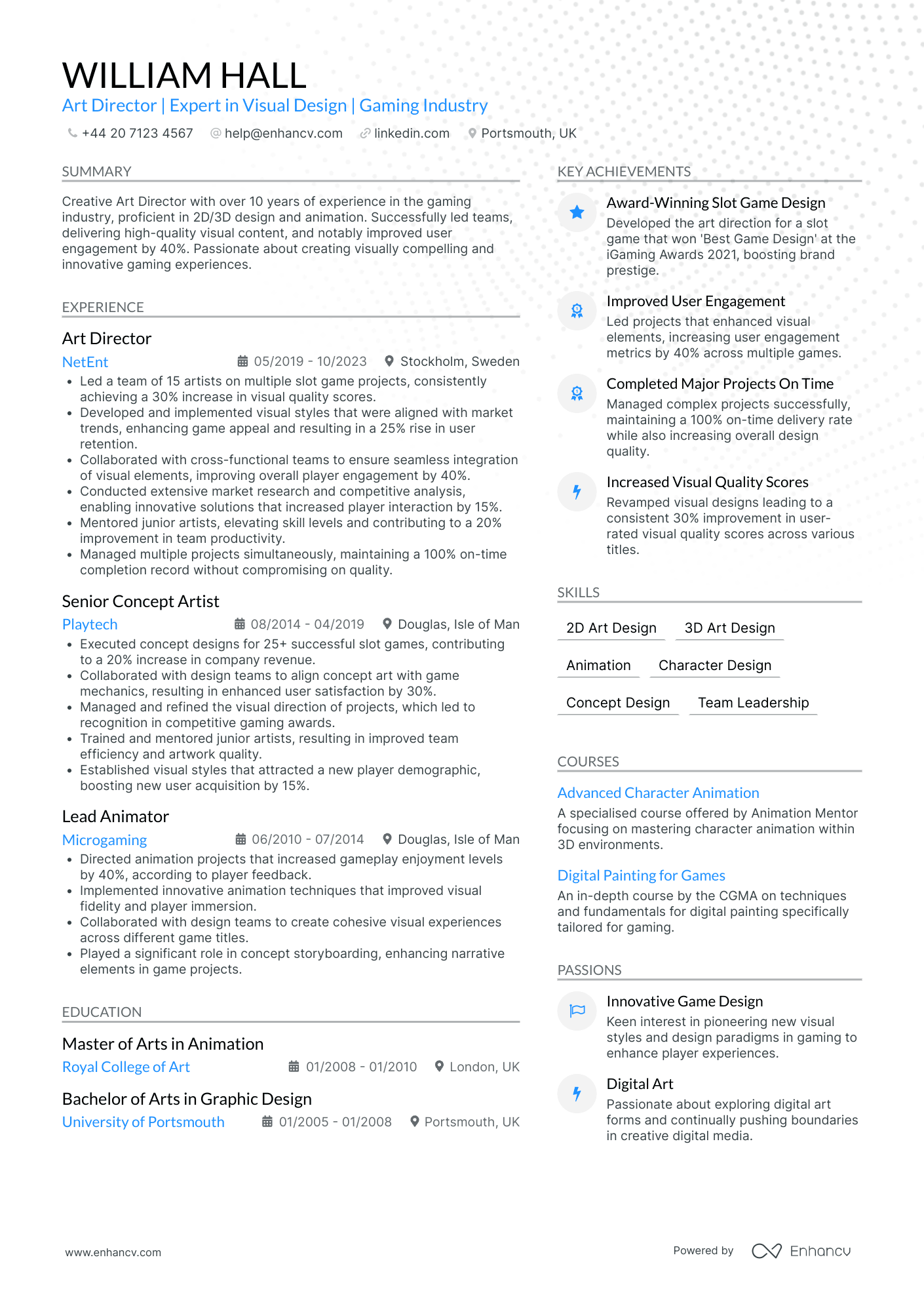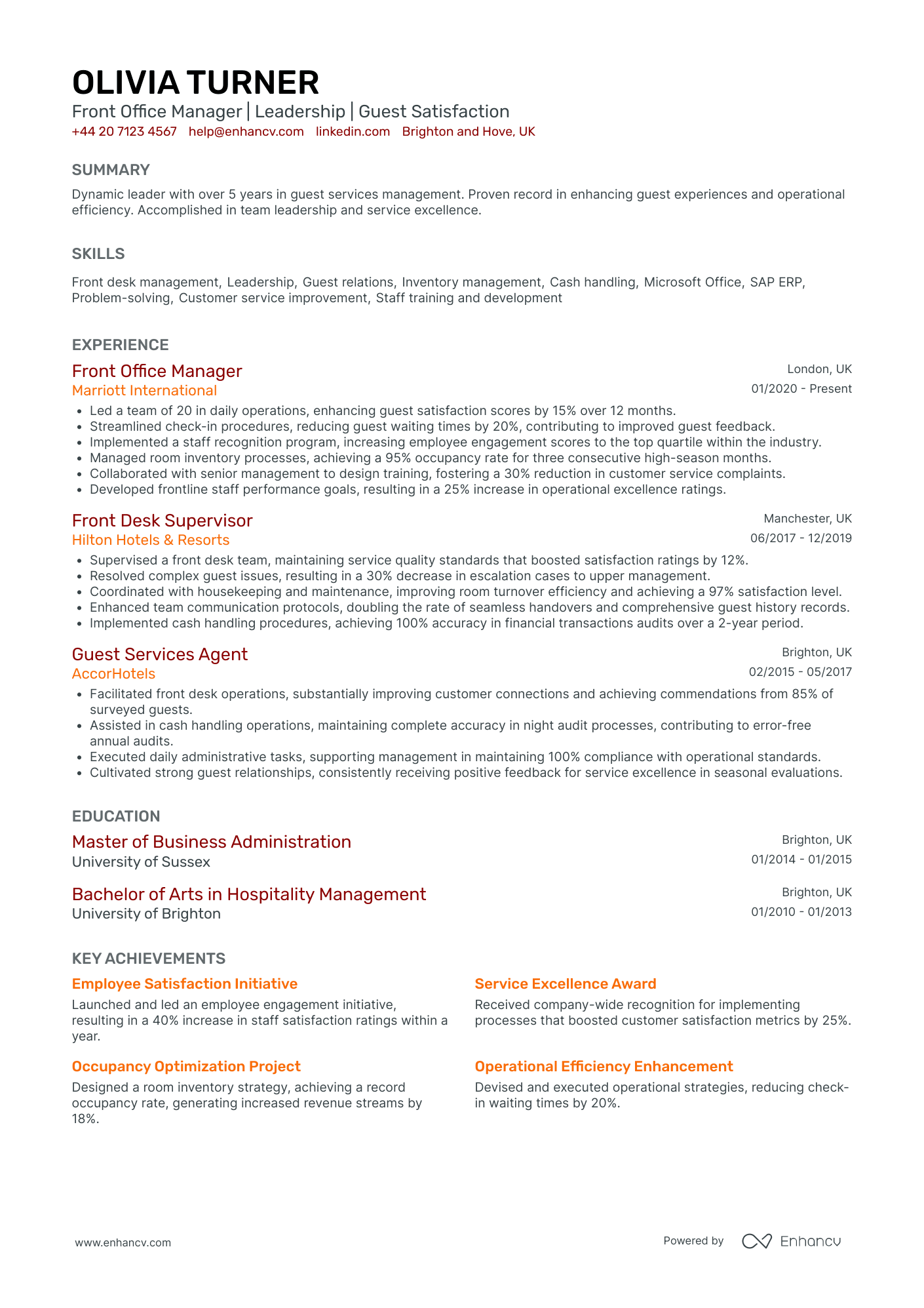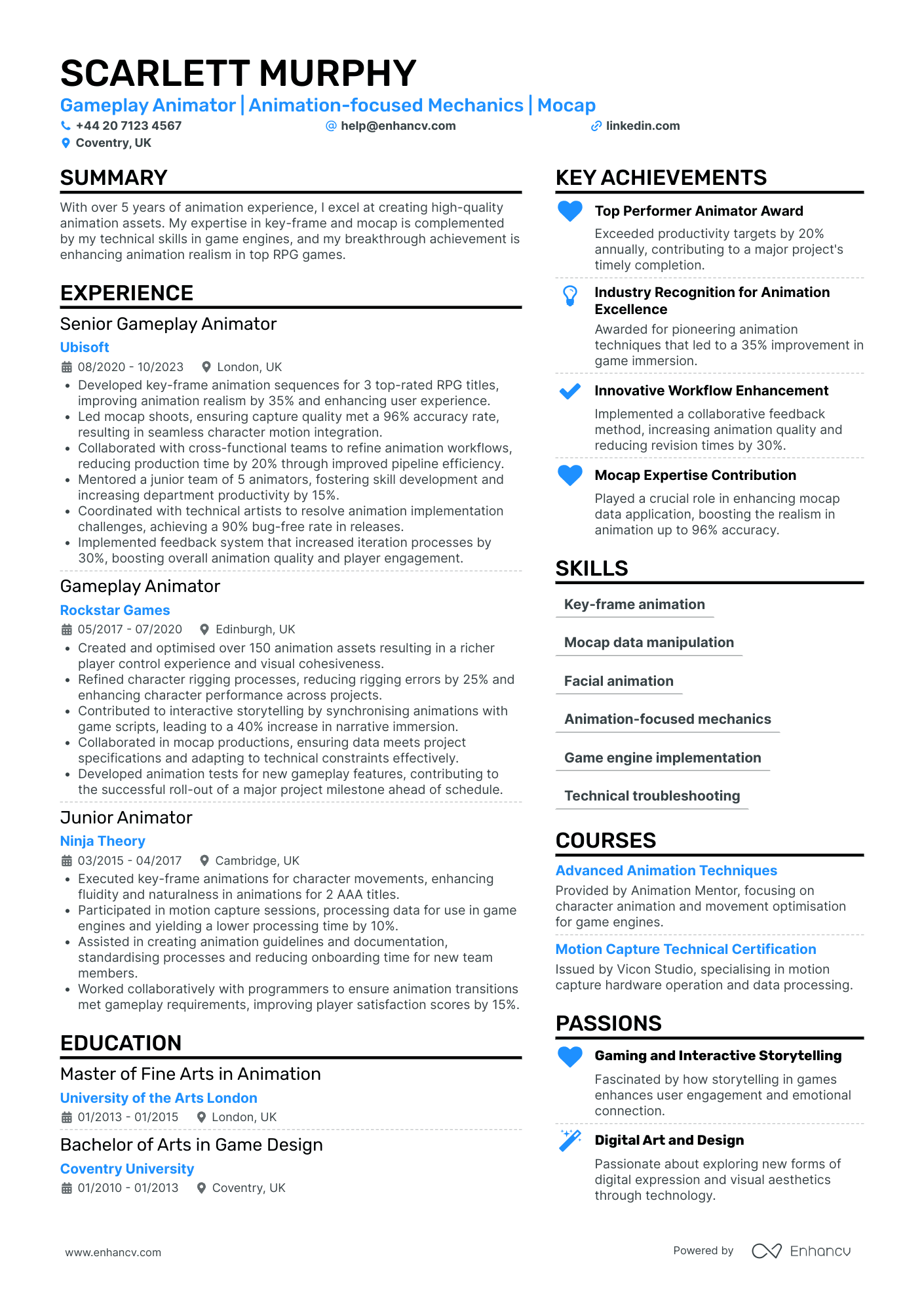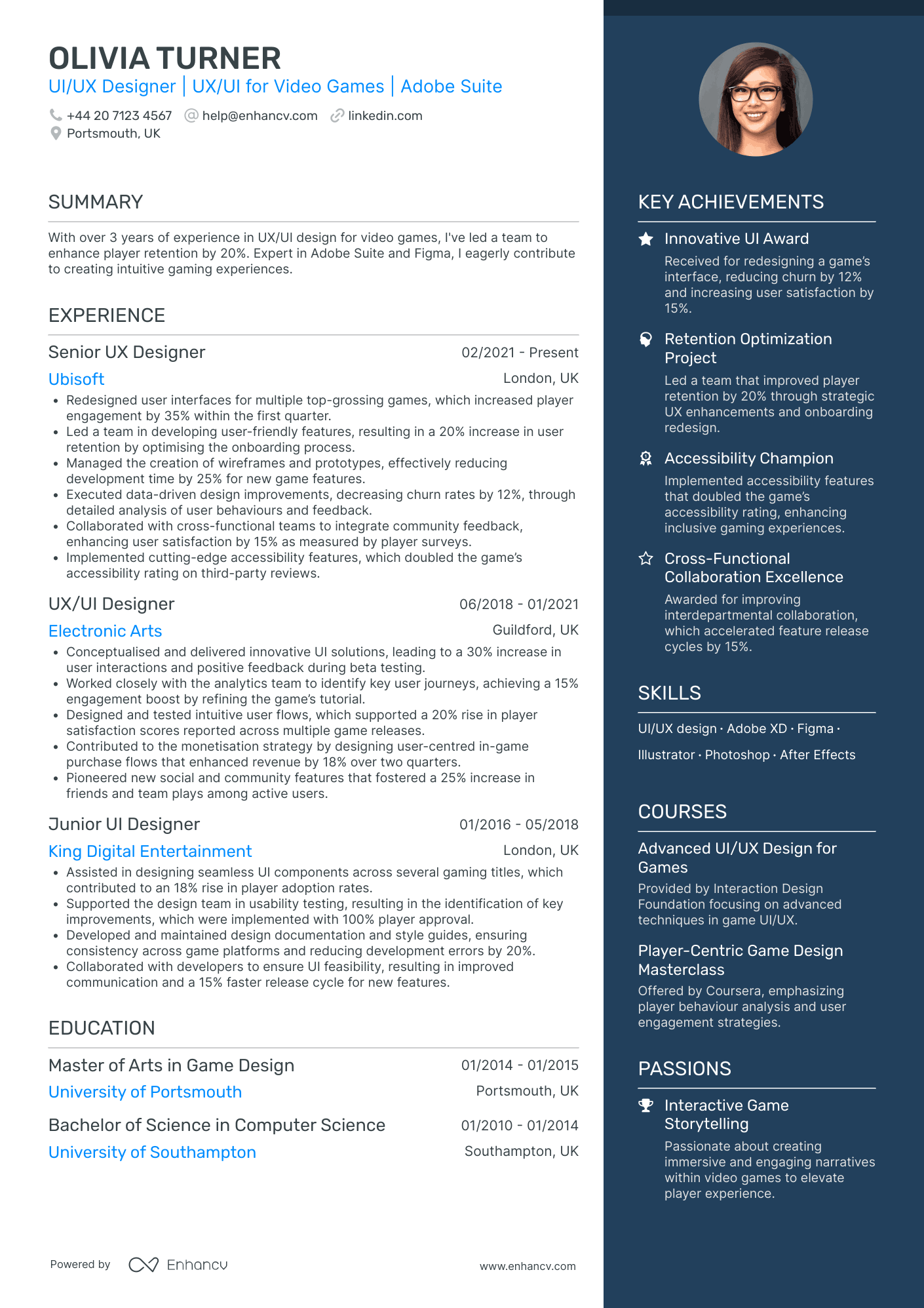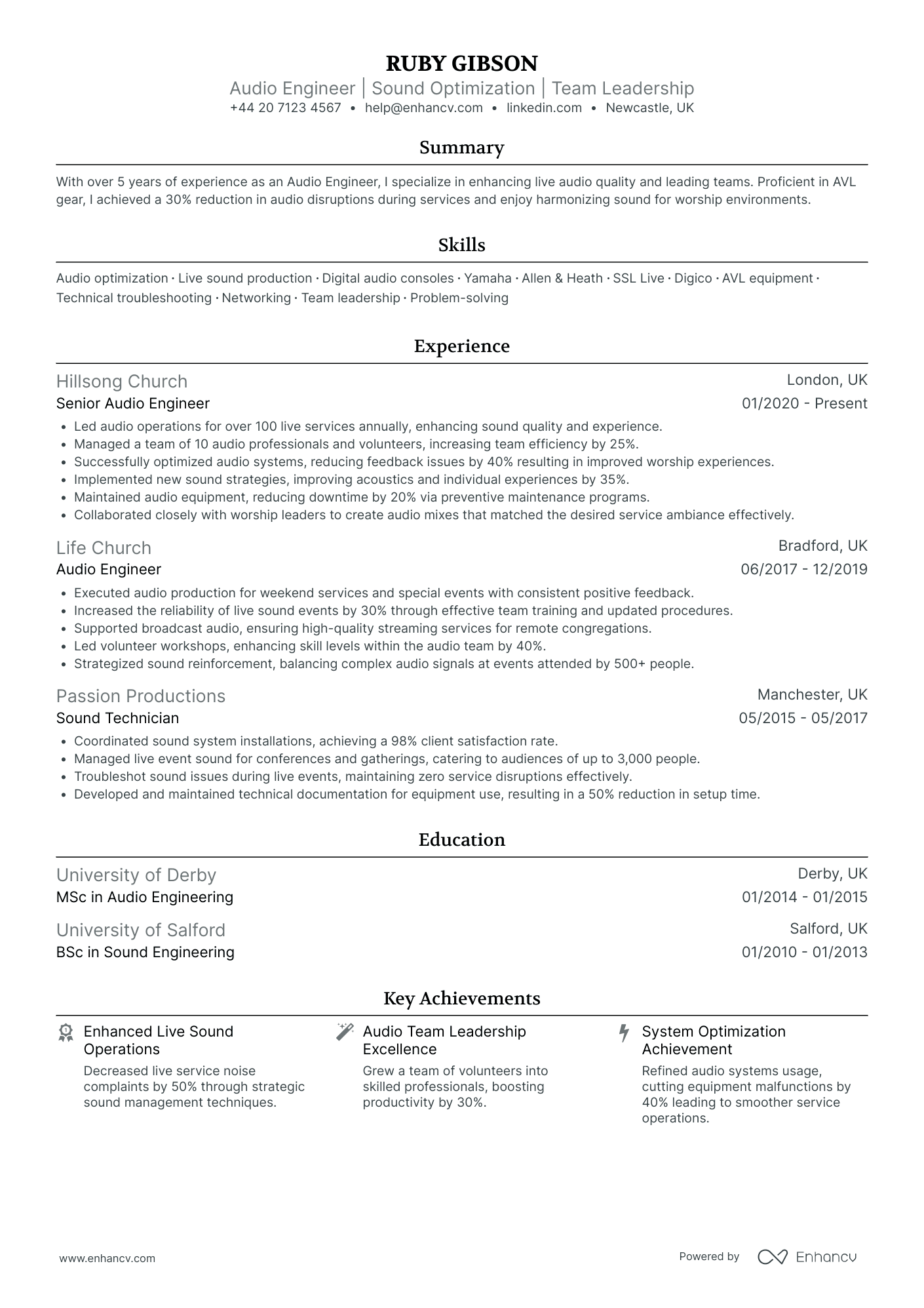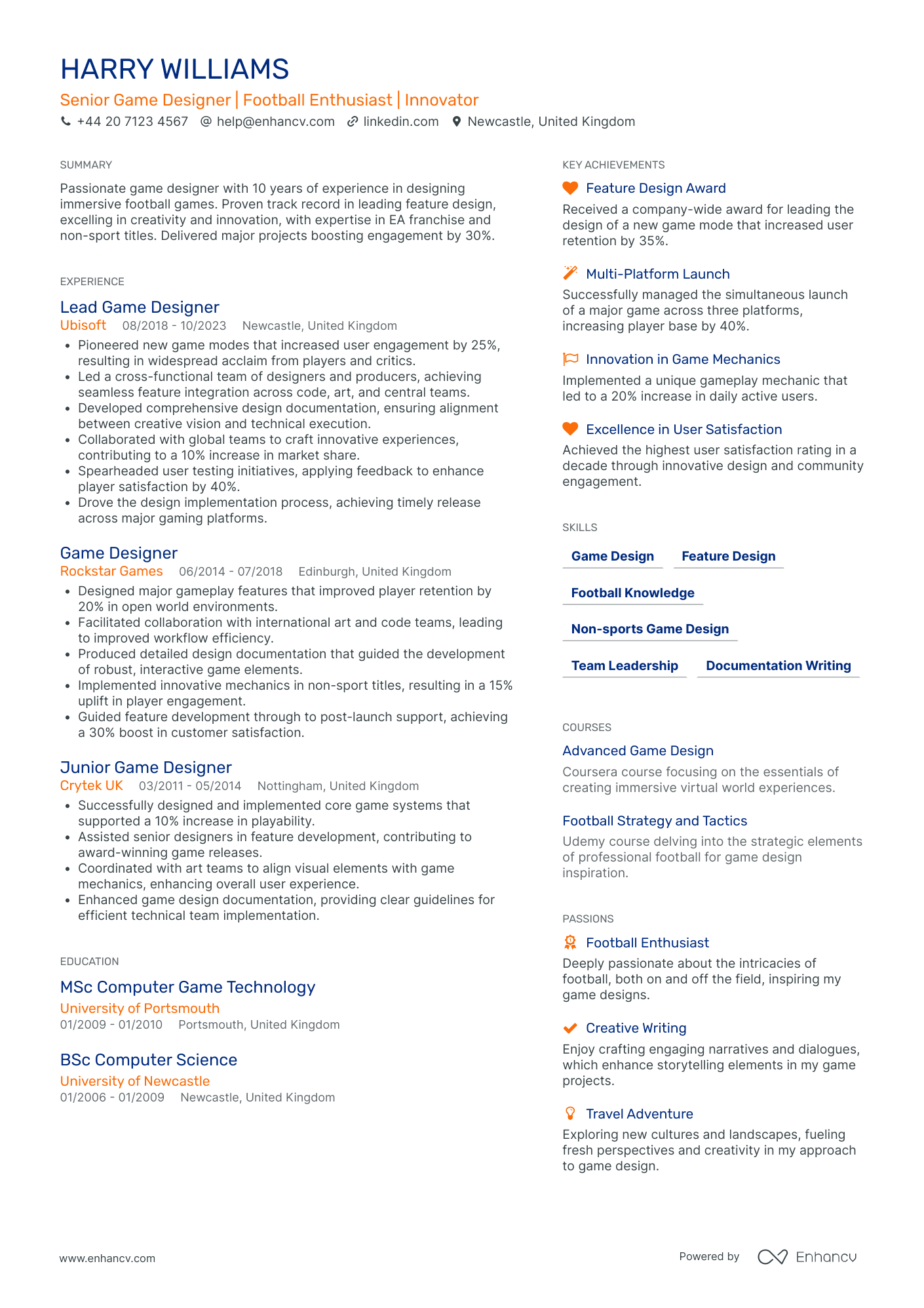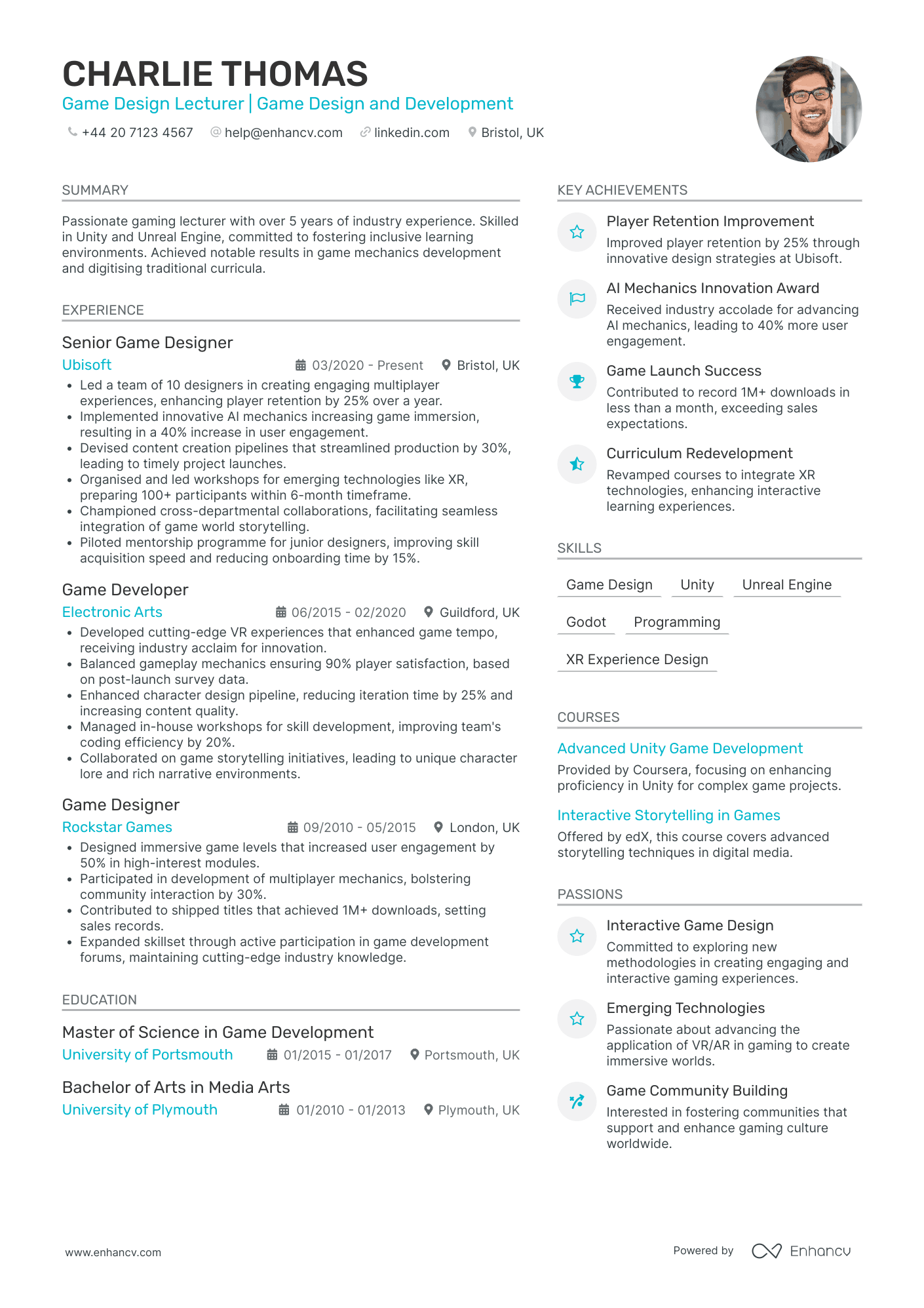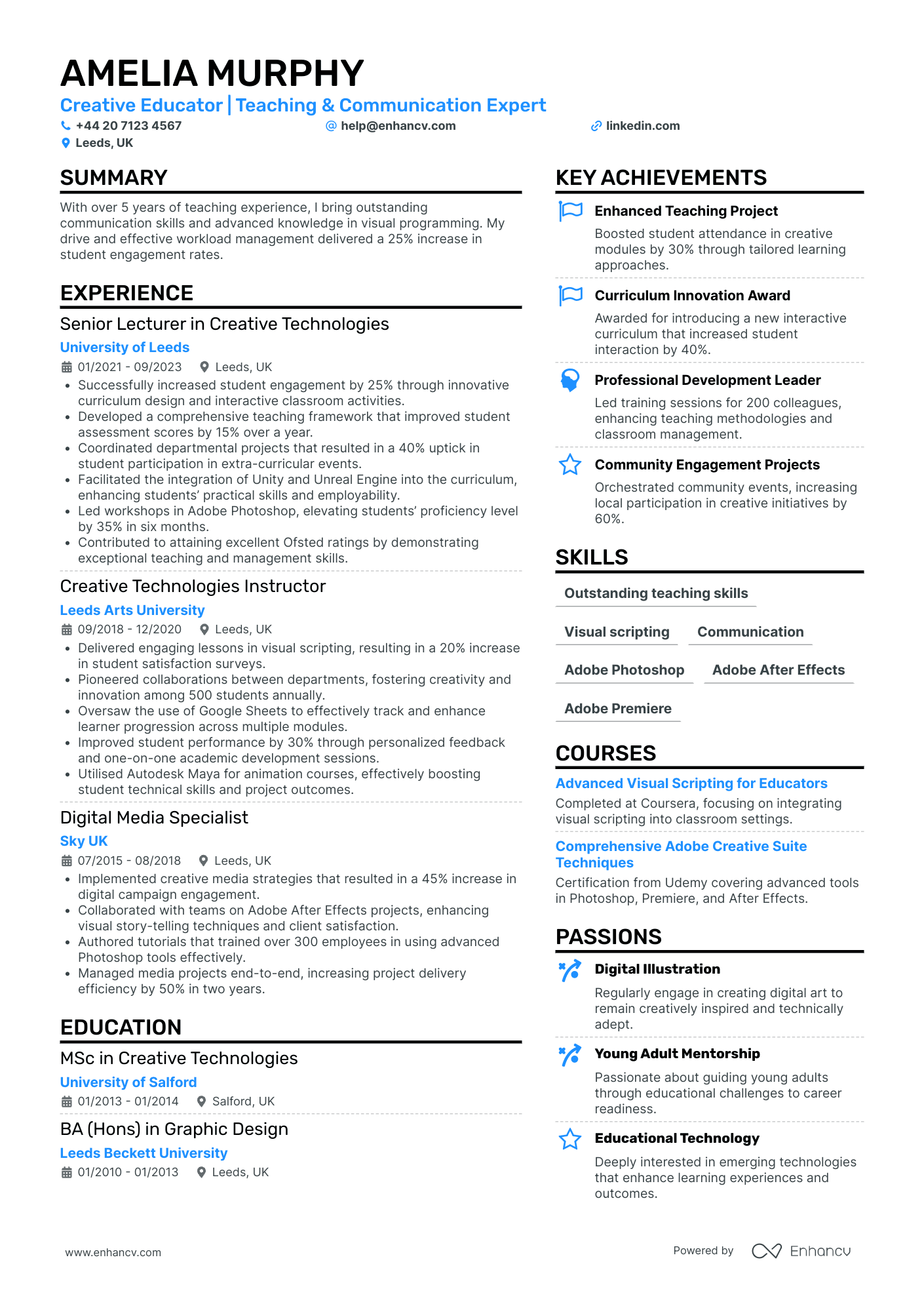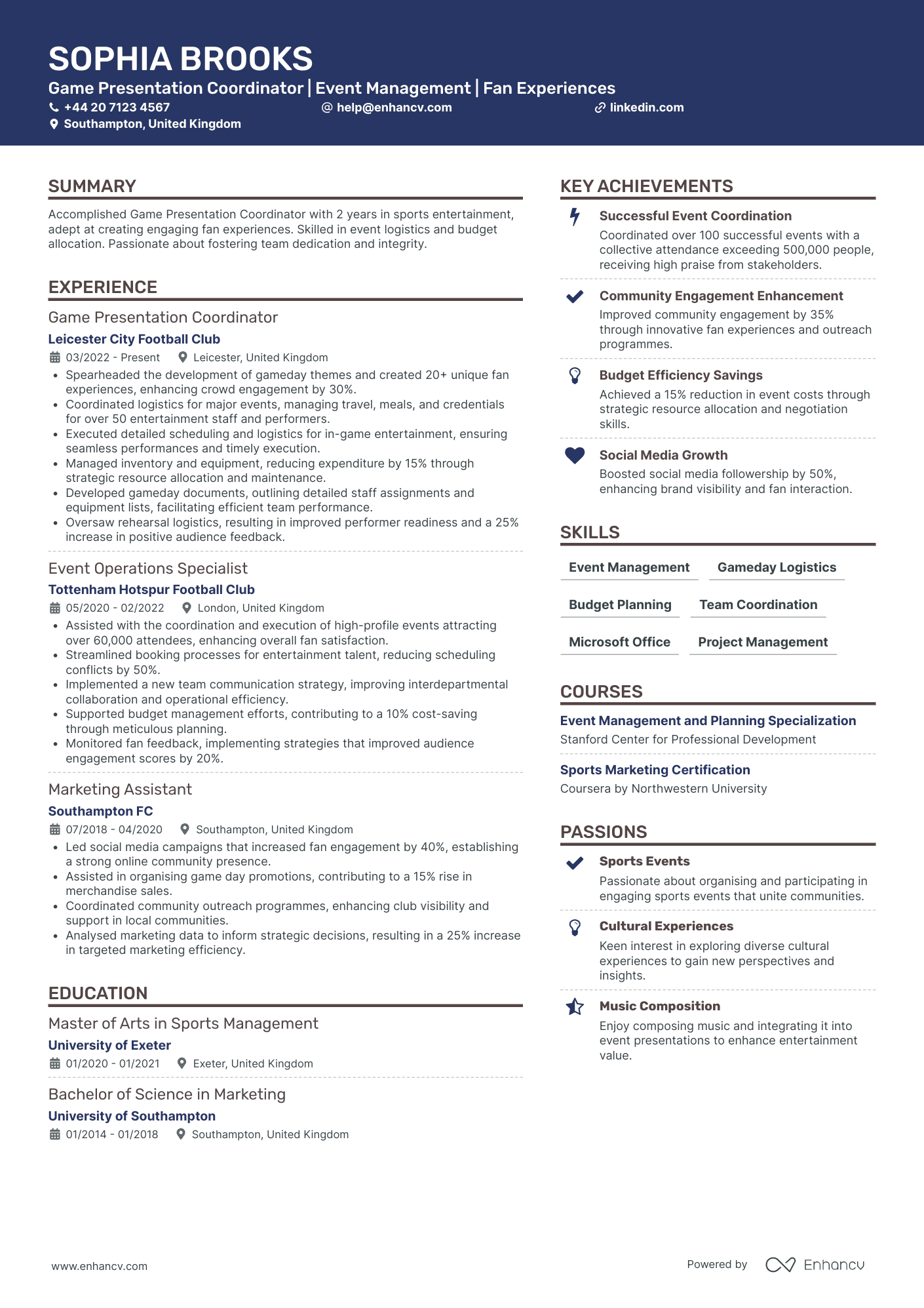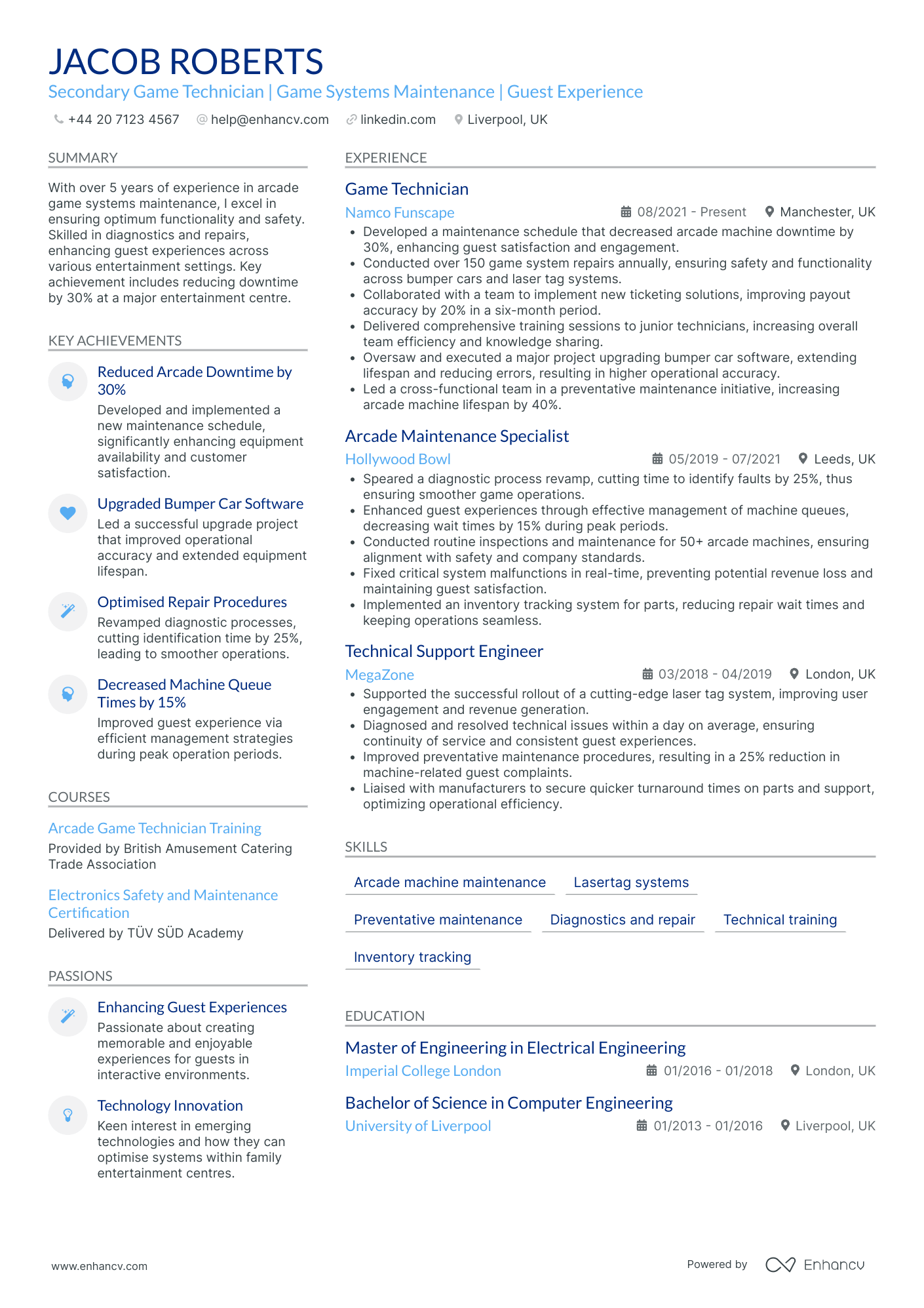Crafting realistic AI behaviour in your game design ventures poses a significant computer vision (CV) challenge, often requiring sophisticated pattern recognition and decision-making mechanisms. Our guide offers in-depth strategies and tools to enhance your CV implementations, ensuring your non-player characters move and react in believable ways, enriching player immersion.
- Answer job requirements with your game design CV and experience;
- Curate your academic background and certificates, following industry-leading CV examples;
- Select from +10 niche skills to match the ideal candidate profile
- Write a more succinct experience section that consists of all the right details.
Do you need more specific insights into writing your game design CV? Our guides focus on unique insights for each individual role:
Resume examples for game design
By Experience
Game Design Intern
- Showcases strong event coordination capabilities - Mia Ward's CV highlights her considerable experience in managing sports events, which is immediately relevant to the sports industry. Her role as a Sports Events Coordinator at Sport Birmingham illustrates her ability to lead complex logistical operations, enhance participant satisfaction, and boost volunteer retention—all of which are crucial for executing successful events.
- Emphasizes her passion for community engagement - The volunteer experience section showcases Mia's dedication to fostering community spirit, particularly through her role as a Youth Sports Coach with StreetGames. This commitment to community involvement is a compelling attribute for roles in sports management, aligning well with her desire to work in team-centric environments while making a positive impact.
- Diversified skill set beyond direct sports roles - Mia's background in customer service, event logistics, and social media management reflects her adaptable skillset. Her involvement in marketing promotions and her achievements in social media campaigns underscore her ability to increase engagement and visibility—key elements for a dynamic career in sports marketing and game operations.
Senior Game Designer
- Compelling demonstration of leadership and team management - Mia Ward’s CV highlights her exceptional leadership skills, evident in her ability to lead a 30-member cross-disciplinary team to a successful AAA game launch. The document illustrates her capacity for increasing productivity and mentoring junior staff, fostering a culture of growth and innovation within her teams.
- Significant achievements with a focus on measurable impact - The CV emphasizes Mia’s success in the gaming industry with quantifiable achievements. From enhancing user engagement by 25% in the first quarter post-launch to a 15% increase in player retention rates, these metrics provide a clear picture of her effectiveness in achieving business objectives within the gaming industry.
- Extensive technical expertise and industry-specific knowledge - Mia’s proficiency in proprietary game engines and her experience with comprehensive game mechanics framework development showcase her technical depth. Her ability to optimize game engines and systems underlines her competence in improving production efficiency and gameplay, catering to the demands of AAA game development.
Junior Game Designer
- Showcases a Strong Career Progression - Freya Richardson's CV effectively outlines her career trajectory from an intern at Codemasters to a Junior Level Designer at Ubisoft Reflections. This progression demonstrates her ability to take on increased responsibilities and adapt to more complex projects within a short span of time, reflecting her commitment and growth in the game design field.
- Emphasis on Industry-Specific Tools and Techniques - The CV highlights Freya's proficiency with key industry tools like Unreal Engine 4 and 5 and methodologies such as blueprint scripting and greyboxing, which are crucial for the role she seeks. These skills underline her technical depth and readiness for challenges in level design and gameplay creation.
- Interdisciplinary Collaboration and Mentorship Skills - Freya's experience collaborating with multidisciplinary teams and her role in mentoring interns indicates strong soft skills, particularly in teamwork and leadership. Her ability to integrate narrative and gameplay elements emphasizes her adaptability and readiness to inspire and elevate the team around her.
Game Design Lead
- Outstanding Career Progression - Isla King's CV details a significant career trajectory from a Junior Gameplay Designer to a Lead Gameplay Designer, emphasizing promotions and leadership roles in renowned companies like Rocksteady Studios and Guerrilla Games. This career path highlights not only personal growth but also increasing responsibilities and trust within the industry.
- Demonstrates Technical Prowess and Innovation - The document showcases deep technical expertise, particularly in the action RPG genre, through accomplishments in AI development, character design, and combat mechanics. The achievements in pioneering character interaction overhauls and innovative NPC behaviors underline a strong ability to push the limits of game design.
- Focus on Collaborative and Leadership Skills - Isla King is portrayed as a strong leader and collaborator, with experience leading design teams to refine gameplay systems and foster cross-department collaboration, boosting productivity and project efficiency. The CV highlights mentoring junior team members and developing robust QA processes, showcasing effective team leadership and problem-solving abilities.
Game Design Director
- Clear and Structured Presentation - The CV is meticulously organized with distinct sections, allowing for easy navigation and quick information retrieval. Key points are concisely presented, maintaining clarity throughout, which is crucial for a Game Director role where both vision and precision are essential.
- Impressive Career Trajectory - Finley Robinson's career shows a consistent upward trajectory, moving from a Game Systems Designer to a Game Director. This progression highlights both growth and expertise, demonstrating their ability to adapt and excel in increasingly complex roles within the gaming industry.
- Innovation and Technical Prowess - The CV highlights Robinson’s proficiency with industry-standard tools like Unreal Engine and emphasizes achievements in gameplay loop innovation and cross-platform launches. Such expertise is fundamental in driving creative and technical breakthroughs as a Game Director.
Assistant Game Designer
- Clear and Organized Content Presentation - The CV is well-structured, presenting information in a clear and concise manner. Sections such as experience, skills, and achievements are distinctly separated, making it easy for hiring managers to navigate and absorb key details quickly. This emphasizes the candidate’s ability to communicate effectively and prioritize critical information.
- Progressive Career Trajectory - Leo's career shows a consistent upward trajectory, moving from a Level Designer role to a Lead Game Designer position. This progression illustrates not just growth in responsibilities and expertise but also recognition within reputable companies in the gaming industry, like Ubisoft and Ninja Theory.
- Adaptability and Cross-Functional Experience - Leo demonstrates significant adaptability by effectively collaborating with diverse teams across different departments and with third-party developers. This cross-functional experience highlights his capacity to integrate varied perspectives and expertise, which is crucial for successful project execution in the gaming industry.
By Role
Game Design Consultant
- Structured and Concise Content Presentation - The CV is organized in a coherent manner with distinct sections for experience, education, skills, and achievements, making it easy to navigate. Each element is succinctly presented, ensuring clarity without overwhelming detail, which aids in quick understanding of the candidate's qualifications and accomplishments.
- Progressive Career Trajectory - The CV outlines a clear career progression from Game Designer to Senior Game Developer and eventually to Assistant Teaching Professor. This progression illustrates a journey of increasing responsibility and expertise, moving from hands-on game development to shaping future professionals in academia.
- Versatile Use of Industry-Specific Tools and Methodologies - The candidate demonstrates expertise in leading game engines such as Unity and Unreal, coupled with a strong grasp of Agile development methodologies. This highlights their technical depth and versatility, crucial for roles in game design and development, ensuring the capability to manage complex projects efficiently.
Game Design Project Manager
- Strategic Vision and Leadership - Isaac Scott's CV showcases strong leadership qualities by consistently driving global initiatives and strategic operations that have led to significant improvements in client satisfaction. His ability to lead cross-functional teams to success and maintain alignment with C-level stakeholders highlights his vision and leadership in the video gaming industry.
- Progressive Career Development in Gaming - The CV illustrates a clear career progression, from Associate Project Manager to Senior Project Manager roles, demonstrating growth and expertise in managing increasingly complex projects. This trajectory underscores his deepening knowledge and capability within the video gaming sector, solidifying his reputation in project management.
- Tangible Achievements with Business Impact - Scott's accomplishments, such as boosting European market sales by 40% for a major localization project and improving project delivery speed by 20% through best practice implementation, are not only quantified but also illustrate the substantial business impact and value he brings to his roles.
Game Design Quality Assurance Specialist
- Strategic Career Progression - Starting as a Quality Assurance Specialist at Ubisoft and progressing to a Senior Quality Assurance Tester at Riot Games, the CV showcases continuous professional growth. This upward trajectory within leading gaming companies highlights adaptability, learning, and mastery of complex gaming quality factors, underlining a successful career in quality assurance.
- Integration of Advanced Testing Techniques - The CV effectively demonstrates the use of industry-relevant tools and methodologies such as automated testing, regression testing, and comprehensive test case design. These technical proficiencies not only ensure product quality but also enhance the overall player experience, showing the candidate’s deep understanding of QA practices specific to the gaming industry.
- Impact-Driven Achievements - The candidate's achievements are articulated with direct business impacts, such as enhancing player satisfaction by 10% and boosting productivity by implementing new regression testing strategies. These accomplishments demonstrate a clear connection between their work and tangible improvements in product quality, team efficiency, and user satisfaction, proving their effectiveness in the role.
Game Design Researcher
- Prominent Career Growth in the Gaming Industry - George Johnson's CV reflects a strong upward trajectory in the highly competitive gaming industry, advancing from a Junior Game Designer at Playtech to a leadership role at NetEnt. His progression marks substantial professional development and increased responsibility, underscoring his expertise and dedication to his field.
- Strong Emphasis on Innovation and Game Development - The CV highlights specialized gaming skills such as game design and mathematical modeling, essential for creating engaging and successful games. George’s ability to increase player engagement and market reach showcases his innovative approach and grasp of industry trends, making him an asset in any forward-thinking game development team.
- Impressive Achievements with Business Impact - The CV includes notable achievements such as winning the Innovative Game Concept Award and contributing to an award-winning game that significantly extended market reach. These accolades not only reflect George's proficiency in game design but also emphasize his capability to drive success and deliver value to gaming companies.
Game Design Art Director
- Structured Presentation with Clear Hierarchy - The CV stands out due to its well-organized format, which effectively utilizes sections such as experience, education, and achievements. Each section is clearly delineated, allowing the reader to easily navigate through the document, while the bullet points provide succinct yet detailed descriptions of roles and accomplishments.
- Impressive Career Growth and Diverse Industry Experience - William Hall's progression from Lead Animator to Art Director within reputable companies like NetEnt and Playtech showcases his upward trajectory in the gaming industry. This career advancement, coupled with his international experience in locations such as Stockholm and the Isle of Man, underlines his adaptability and commitment to professional growth.
- Emphasis on Leadership and Collaboration Skills - A major highlight of this CV is William Hall’s leadership qualities, evidenced by his management of cross-functional teams and mentoring of junior artists. His ability to enhance team productivity by 20% and maintain a 100% on-time project completion rate reflects his strong leadership and effective collaboration skills, vital for an Art Director in the gaming industry.
Game Design Script Writer
- Clear organization and focused presentation - The CV is well-structured and easy to follow, with distinct sections for experience, education, skills, courses, achievements, languages, and passions. Each section is concise yet informative, highlighting key accomplishments and qualifications that are directly relevant to the role of Front Office Manager.
- Comprehensive career progression in hospitality management - Olivia Turner’s career path reflects a steady growth within the hospitality industry, progressing from a Guest Services Agent to a Front Desk Supervisor, and ultimately to a Front Office Manager. This trajectory not only shows upward mobility and increased responsibility but also signifies her capability to adapt and excel across different facets of guest services.
- Emphasis on impactful achievements and operational efficiency - The CV highlights several key accomplishments, such as leading initiatives that decreased guest waiting times and improved satisfaction scores. These achievements are quantified and connected to business outcomes, demonstrating Olivia’s ability to positively impact operational efficiencies and contribute to the organization's success.
Game Design Animator
- Effective Content Structure - The CV is well-organized, presenting key elements such as experience, education, skills, and achievements in an order that aligns with industry expectations. This clarity and structure make it easy for hiring managers to quickly assess Scarlett's qualifications and relevance to the role.
- Progressive Career Trajectory - Scarlett’s career path illustrates significant growth, starting from a Junior Animator role at Ninja Theory to becoming a Senior Gameplay Animator at Ubisoft. This trajectory highlights a consistent advancement in responsibilities and expertise, reflecting her capability to take on increasing challenges in the animation industry.
- Industry-Specific Expertise - The CV effectively showcases Scarlett’s expertise in animation methodologies and tools, such as key-frame animation and mocap data manipulation, which are crucial for gameplay animation roles. Her technical depth in game engine implementation further emphasizes her readiness to deliver in high-performance environments.
Game Design UI/UX Designer
- Career Growth and Advancements - Olivia Turner's career demonstrates a solid progression from a Junior UI Designer to a Senior UX Designer in the gaming industry. Her steady advancement illustrates a strong track record of professional development and increasing responsibilities. Each role builds on her experience, showcasing her ability to take on complex projects and lead teams effectively.
- Technical Expertise and Industry Tools - The CV highlights Olivia's proficiency with industry-standard tools like Adobe Suite, Figma, and her understanding of player behavior analysis, which is crucial for creating seamless gaming experiences. Her expertise in prototyping and wireframing shows a deep technical breadth that is specific to UI/UX design for video games, positioning her as a valuable asset in this niche.
- Achievements with Business Impact - The documented achievements section emphasizes the practical impact of her work, such as increasing player retention by 20% and boosting user engagement by 35%. These accomplishments illustrate her ability to translate creative design into quantifiable business results, presenting her as a designer who not only focuses on aesthetics but also considers user satisfaction and business growth.
Game Design Audio Engineer
- Clear and Effective Content Structure - Ruby Gibson’s CV is structured for clarity, presenting crucial information in a concise and orderly manner. Each section is clearly defined, making it easy to navigate through her professional background, achievements, skills, and education. The layout ensures that important details are highlighted, while summaries help in quickly understanding her expertise and career goals.
- Impressive Career Growth and Leadership Roles - Ruby's career trajectory showcases significant growth, with advancement from Sound Technician to Senior Audio Engineer within prominent organizations. Her progression reflects her increasing responsibilities and leadership capabilities, notably managing a team and optimizing audio operations at Hillsong Church, which illustrates both advancement and dedication to her field.
- Industry-Specific Expertise and Technical Proficiency - The CV highlights Ruby’s deep technical knowledge, evidenced by her proficiency with AVL equipment and digital audio consoles, such as Yamaha and Digico. These are crucial tools in audio engineering, indicating her technical depth and ability to leverage advanced technologies to enhance audio quality and performance in various settings.
Game Design Producer
- Clarity and Structured Presentation - The CV is presented in a structured manner that facilitates easy navigation through different sections. Key areas such as experience, education, and skills are clearly delineated, allowing potential employers to quickly comprehend Harry Williams' qualifications and experience. Each section is concise and to the point, enhancing readability and ensuring key points are not lost in unnecessary detail.
- Diverse Career Trajectory - The candidate's career trajectory highlights a clear path of consistent growth. Starting as a Junior Game Designer at Crytek UK and progressing to a Lead Game Designer at Ubisoft, this CV showcases not only personal advancement but also an ability to work with different top-tier gaming companies, enriching Harry's exposure to varied industry practices and strategies.
- Cross-Functional Leadership and Innovation - The CV illustrates Harry's proficiency in leading cross-functional teams and spearheading innovative projects. Leadership skills are emphasized through mentions of team management and successful collaborative initiatives across art and technical teams, which are critical in game design for cohesive project execution. This adaptability to work across different functions highlights his comprehensive understanding of both the creative and technical sides of game development.
Game Design Lecturer
- Strong career growth and industry presence - Charlie Thomas' career trajectory highlights a clear progression from Game Designer at Rockstar Games to a Senior Game Designer at Ubisoft. This steady advancement illustrates increasing responsibility and expertise in game design and development, highlighting his upward movement within the gaming industry.
- Depth of technical skills and tools - The CV showcases proficiency in key industry tools such as Unity, Unreal Engine, and Godot, as well as expertise in VR/AR development and AI in games. This technical depth marks Charlie as a versatile developer capable of adapting to emerging technologies, which is crucial in the rapidly evolving gaming sector.
- Emphasis on leadership and cross-functional collaboration - The experience descriptions emphasize Charlie's leadership capabilities, such as leading a team of designers at Ubisoft and organizing workshops to improve integration across departments. These details highlight his ability to foster teamwork and drive successful, multi-disciplinary projects.
Game Design Tutor
- Career Growth and Impact - The career trajectory of Amelia Murphy is clearly articulated, showcasing a steady progression from Creative Technologies Instructor to a Senior Lecturer position. This demonstrates her ability to advance in her field, reflected in her increasing responsibilities, such as leading workshops and coordinating departmental projects. This career path illustrates not only her professional growth but also her capacity to impact student engagement and educational outcomes positively.
- Technical Proficiency and Innovation - Amelia's CV stands out by emphasizing her extensive technical skills and innovative approaches to teaching. Her experience with tools like Unity, Unreal Engine, and Autodesk Maya underscores her proficiency in cutting-edge educational technologies. Additionally, integrating such tools into curriculum positions her as a forward-thinking educator, focused on enhancing students’ practical skills and employability in the creative sector.
- Diverse Achievements with Broader Implications - The CV effectively highlights Amelia's significant achievements, such as boosting student engagement and performance, which are tied to tangible educational outcomes. More notably, her initiatives led to institutional gains like improved Ofsted ratings and heightened participation in extra-curricular activities, indicating her contributions extend beyond classroom success. Her accomplishments are presented not merely as numbers but as meaningful impacts that enhance the broader educational environment.
Game Design Coordinator
- Clear and Structured Content - The CV is organized in a way that highlights Sophia's key competencies and experiences efficiently. Each section is well-defined, ensuring clarity for the reader. Her experience is showcased with bullet points, detailing her achievements and responsibilities concisely, which makes it easy to digest her capabilities at a glance.
- Progressive Career Advancement - Sophia's career trajectory demonstrates a clear path of progression within the sports event management industry. Starting as a Marketing Assistant and advancing to Game Presentation Coordinator shows a successful climb in roles, indicating dedication to her field and the continuous acquisition of skills and responsibilities.
- Achievements with Strategic Impact - The CV details significant achievements, such as enhancing crowd engagement by 30% and reducing costs by 15%, indicators of not just completing tasks but driving meaningful business results. These achievements underscore her resourcefulness and effectiveness in delivering superior fan experiences and operational efficiency.
Game Design Technician
- Clear and Methodical Presentation - The CV is structured logically, starting with a concise summary that provides a snapshot of the candidate's expertise. Each section is well-organized, with bullet points that clearly highlight responsibilities and achievements, allowing for quick and effective assimilation of the candidate's skills and experience.
- Consistent Career Growth in Technical Roles - Jacob Roberts’ career trajectory shows a steady progression in the arcade and entertainment industry, evolving from a Technical Support Engineer to a Game Technician at respected companies. This progression highlights his growing expertise and increased responsibilities in technical maintenance and staff training within complex entertainment systems.
- Impact of Achievements on Business Performance - The CV demonstrates the candidate's ability to drive business improvements. Notably, the development of a new maintenance schedule that reduced downtime by 30% underscores his contributions to operational efficiency, customer satisfaction, and ultimately, the financial health of the entertainment venues he's worked for.
How to ensure your profile stands out with your game design CV format
It's sort of a Catch 22. You want your game design CV to stand out amongst a pile of candidate profiles, yet you don't want it to be too over the top that it's unreadable. Where is the perfect balance between your CV format simple, while using it to shift the focus to what matters most. That is - your expertise. When creating your game design CV:
- list your experience in the reverse chronological order - starting with your latest roles;
- include a header with your professional contact information and - optionally - your photograph;
- organise vital and relevant CV sections - e.g. your experience, skills, summary/ objective, education - closer to the top;
- use no more than two pages to illustrate your professional expertise;
- format your information using plenty of white space and standard (2.54 cm) margins, with colours to accent key information.
Once you've completed your information, export your game design CV in PDF, as this format is more likely to stay intact when read by the Applicant Tracker System or the ATS. A few words of advice about the ATS - or the software used to assess your profile:
- Generic fonts, e.g. Arial and Times New Roman, are ATS-compliant, yet many candidates stick with these safe choices. Ensure your CV stands out by using a more modern, and simple, fonts like Lato, Exo 2, Volkhov;
- All serif and sans-serif fonts are ATS-friendly. Avoid the likes of fancy decorative or script typography, as this may render your information to be illegible;
- Both single- and double-column formatted CVs could be assessed by the ATS;
- Integrating simple infographics, icons, and charts across your CV won't hurt your chances during the ATS assessment.
PRO TIP
Use font size and style strategically to create a visual hierarchy, drawing the reader's eye to the most important information first (like your name and most recent job title).
The top sections on a game design CV
- Game Design Portfolio showcases your practical skills and creativity.
- Professional Experience details your past roles and contributions.
- Education Background displays relevant qualifications and training.
- Technical Skills highlight the specific game development tools you excel in.
- Project Management Experience shows your ability to lead and work in teams.
What recruiters value on your CV:
- Highlight your game development skills by detailing your experience with game engines like Unity or Unreal Engine, and specify any scripting languages you're proficient in such as C# or C++.
- Include a concise section about your design philosophy, focusing on how you approach gameplay mechanics, story development, and player engagement to convey your creative thought process.
- Showcase your portfolio with links to games you've contributed to, emphasising your specific roles and achievements within those projects, whether they are published titles or concept prototypes.
- Detail your understanding of the game development lifecycle, from concept to post-release, demonstrating your ability to work effectively within different stages such as pre-production, production, and live operations.
- Mention your collaborative skills by describing successful team-oriented projects, and how you've communicated with artists, programmers, and other stakeholders to realise a cohesive game experience.
Recommended reads:
What information should you include in your game design CV header?
The CV header is potentially the section that recruiters would refer to the most, as it should include your:
- Contact details - your professional (non-work) email address and phone number;
- Professional photograph - if you're applying hinting at the value you bring as a professional.
Many professionals often struggle with writing their game design CV headline. That's why in the next section of this guide, we've curated examples of how you can optimise this space to pass any form of assessment.
Examples of good CV headlines for game design:
- "Lead Level Designer | Environmental Storytelling Expert | 8 Years Experience | Advanced AI Integration | Unreal Engine Pro"
- "Senior Game Developer | Multi-platform Programming | VR Specialist | Computer Science MSc | 10+ Years in Industry"
- "Gameplay Programmer | Unity Certified | Physics Simulation Enthusiast | Agile Workflow Advocate | 5 Years of Crafting Fun"
- "Art Director | AAA Studio Experience | Award-Winning Visuals | Creative Team Leadership | 12 Years Industry Veteran"
- "Junior Game Designer | Innovative Mechanics Creator | Bachelor of Game Design | Passionate about Player Engagement | 2 Years Experience"
- "UI/UX Designer | Player-Centric Interfaces | Mobile & Console Expertise | HCI Diploma Holder | 7-Year Track Record"
Catching recruiters' attention with your game design CV summary or objective
Located closer to the top of your CV, both the summary and objective are no more than five sentences long and serve as an introduction to your experience. What is more, you could use either to entice recruiters to read on. Select the:
- Summary, if you happen to have plenty of relevant experience. Feature your most impressive accomplishments and up to three skills that are relevant to the job you're applying for;
- Objective, if you're just starting your career off. Provide your career goals and answer how you see the role you are applying for will match your professional growth.
Judging which one you need to add to your game design CV may at times seem difficult. That’s why you need to check out how professionals, with similar to your experience, have written their summary or objective, in the examples below:
CV summaries for a game design job:
- With over five years of dedicated experience as a Senior Game Designer, specialising in RPG mechanics and storytelling, I have successfully led a team to launch a BAFTA-nominated title. Proficient in Unreal Engine 4, Unity, and agile project management, my portfolio showcases a history of creating immersive worlds that captivate players.
- Passionate 3D Artist with a decade in the animation industry, seeking to leverage my expertise in environmental design and character modelling towards a new challenge within game development. Skilled in Maya, ZBrush, and Substance Painter, I bring a unique artistic vision that has been honed through work on award-winning animated features.
- Accomplished Web Developer transitioning into game design, blending 6 years of coding experience with a lifelong passion for gaming. Adept in JavaScript, C#, and HTML5, I aspire to combine my technical skills with creative game concepts to develop engaging gameplay experiences.
- Dynamic Marketing Professional shifting focus to game design after 7 years of crafting compelling narratives for global brands. With a strong foundation in storytelling and audience engagement, I aim to apply my content creation and analytical skills to the realm of interactive entertainment and game storylines.
- Seeking to initiate my professional journey in the exciting field of game design, where I can apply my strong analytical thinking and Bachelor’s in Computer Science. Eager to master game development tools and contribute fresh ideas to drive player engagement within a forward-thinking game studio.
- Aiming to harness my deep-rooted passion for video games and fervent desire for storytelling through an entry-level opportunity in game design. With an academic background in creative writing and recent certifications in game development, I am committed to learning rapidly and adding value to a creative team creating memorable gaming experiences.
Narrating the details of your game design CV experience section
Perhaps you've heard it time and time again, but, how you present your experience is what matters the most. Your CV experience section - that details your work history alongside your accomplishments - is the space to spotlight your unqiue expertise and talents. So, avoid solely listing your responsibilities, but instead:
- adverts' keywords and integrate those in your experience section;
- Use your CV to detail how you've been promoted in the past by including experience in the reverse chronological order.
Before you start writing your game design CV experience section, dive into some industry-leading examples on how to structure your bullets.
Best practices for your CV's work experience section
- Articulate your role in the design and development of games, highlighting any unique mechanics or features that you were responsible for. Include successful iterations or player engagement metrics to showcase the impact of your contributions.
- Demonstrate your ability to collaborate effectively with multidisciplinary teams by providing examples of working with artists, programmers, and other stakeholders to achieve a coherent vision for games.
- Exhibit your understanding of game design principles with specific examples of how you've implemented balance, pacing, feedback loops, and reward systems in your projects.
- Showcase your proficiency in game design tools and software such as Unity, Unreal Engine, or custom scripting languages, including the scope and scale of projects you've worked on using these.
- Detail your experience with user testing and feedback incorporation, explaining how player input has shaped the design decisions and improvements in your games.
- Provide examples of your problem-solving skills, particularly how you've addressed design challenges or technical constraints to enhance the gameplay experience.
- Highlight any experience with live operations, community management, or post-launch content development that has contributed to a game's longevity and community engagement.
- Illustrate your ability to document and communicate game concepts and mechanics clearly through design documents, flowcharts, and presentations to ensure alignment within the development team.
- Mention any experience with narrative design or writing for games, detailing how you've crafted storylines, character arcs, or environmental storytelling to enrich the player's experience.
- Played a pivotal role in the development of an innovative RPG which attracted over 1.5 million downloads within the first year of release.
- Led a team of 5 junior game designers, mentoring them in advanced level design techniques and narrative development that boosted game engagement metrics by 30%.
- Collaborated closely with cross-functional teams to integrate user feedback into game development, seeing a 20% increase in player retention rates.
- Oversaw the conceptualisation and implementation of a major update for a AAA FPS game, enhancing the user experience and expanding the game's lifespan on the market.
- Managed the creation of over 100 unique asset designs, which were critical in diversifying gameplay and maintaining a high level of player interest.
- Streamlined the game prototyping process by introducing agile methodologies, which decreased the prototype development cycle by 40%.
- Spearheaded the game level design for a popular mobile strategy game, contributing to it achieving top 10 status in the strategy category on the App Store.
- Implemented analytics-driven game mechanics changes that enhanced user engagement by 25% and significantly grew monthly average user spend.
- Facilitated cross-departmental workshops to align game design principles with marketing strategies, resulting in increased brand recognition and a 15% jump in quarter-over-quarter player acquisition.
- Designed and launched a successful educational game for children, which was recognised by industry experts for its creativity and impact, contributing to a 200% sales forecast exceedance.
- Devised a comprehensive game balancing framework that improved user satisfaction by creating more competitive and engaging game sessions.
- Collaborated with user experience specialists to optimise game interface, effectively reducing navigation time for players by an average of 15 seconds.
- Led the narrative development for an award-winning open-world adventure game, that later on received critical acclaim for its story depth and character development.
- Directed the integration of virtual reality elements into existing game titles, boosting immersion and garnering a 20% increase in game revenue from VR-enabled content.
- Orchestrated a seamless redesign of game UI/UX, which improved user accessibility and contributed to a 40% reduction in customer support tickets related to usability issues.
- Conceptualised and deployed a real-time multiplayer system for an eSports title, which supported 10,000+ concurrent players and reduced server latency by 50%.
- Developed an in-depth analytics tool for gameplay balancing, enabling the design team to make data-driven decisions that resulted in a 50% increase in player match satisfaction.
- Initiated a community-driven game feature process, incorporating player feedback into the development pipeline and achieving a notable increase in positive game reviews by 45%.
- Developed a custom game engine for an indie game project which supported unique physics mechanics, distinguishing the game in a competitive indie market.
- Curated a storytelling framework that adapted player choices into the narrative, enriching user experience and resulting in high replay value and critical acclaim.
- Pioneered the use of AI-driven NPCs that dynamically responded to player actions, creating a more immersive and realistic gaming environment.
- Championed the user interface design for a cloud-based gaming platform, which supported seamless gameplay across various devices and increased user base by 250,000 within six months.
- Mentored a squad of ten aspiring game designers, providing them with the necessary skills to produce top-tier content that led to a 35% faster production cycle.
- Implemented a rewards-based system within the game that drove daily active user numbers up by 20% and improved long-term player engagement.
Lacking professional expertise: how to write your CV to highlight your best talents
Don't count on your lucky stars when you're applying for a role, where you happen to have less (or almost none) professional experience. Recruiters sometimes do hire inexperienced candidates if they're able to present their unique value from the get-go. So, instead of opting for the traditional, CV experience section:
- List any applicable expertise you happen to have - no matter if it's a part-time job, internship, or volunteer work. This would hint to recruiters that your profile is relevant;
- Focus your CV on your transferrable skills or talents you've obtained thanks to your whole life and work experience. In effect, you'll be spotlighting your value as a candidate;
- Separate more space for your applicable academic background and certificates to show you have the technical know-how;
- Ensure that within your objective, you've defined why you'll like the job and how you'll be the perfect match for it. Always ensure you've tailored your CV to individual applications.
Looking for more good examples for your first job? We'll show you how other candidates, with less professional experience, have created their job-winning CVs.
Recommended reads:
PRO TIP
If you have experience in diverse fields, highlight how this has broadened your perspective and skill set, making you a more versatile candidate.
Hard skills and soft skills to showcase your unique skill set on your game design CV
Did you know that your CV will mostly likely be assessed by recruiters based on skill alignment? And that means that the way you feature your key skills across different CV sections will play a crucial role in landing you that first interview. We recommend you add your:
- technical capabilities or hard skills in your CV experience, certificates, projects, etc. Use your past accomplishments to prove your technical capabilities. List up to a dozen different software or hardware in your dedicated skills section to match the job keywords;
- personal and communication skills or soft skills in your CV strengths, achievements, summary/ objective, etc. Soft skills are a bit more difficult to prove. How do you define your aptitude in active listening? So, instead of just listing the skill name, include a tangible metric to show your success.
On a final note, when you're in a hurry to create your profile, you may misspell a particular technology or soft skill. That's why we suggest you copy and paste the particular skill name (or keyword), directly from the job advert. This would also help you to pass any initial Applicant Tracker System (ATS) tests.
Top skills for your game design CV:
Game Development Fundamentals
Level Design
3D Modeling
Texturing
Scripting and Programming Languages (C++, C#, etc.)
Game Engine Proficiency (Unity, Unreal Engine, etc.)
Animation
User Interface Design
Audio Design
Quality Assurance and Playtesting
Creativity
Problem-Solving
Collaboration
Communication
Attention to Detail
Time Management
Adaptability
Critical Thinking
Passion for Gaming
Leadership
PRO TIP
Focus on describing skills in the context of the outcomes they’ve helped you achieve, linking them directly to tangible results or successes in your career.
Listing your university education and certificates on your game design CV
The best proof of your technical capabilities would be your education and certifications sections. Your education should list all of your relevant university degrees, followed up by their start and completion dates. Make sure to also include the name of the university/-ies you graduated from. If you happen to have less professional experience (or you deem it would be impressive and relevant to your application), spotlight in the education section:
- that you were awarded a "First" degree;
- industry-specific coursework and projects;
- extracurricular clubs, societies, and activities.
When selecting your certificates, first ask yourself how applicable they'd be to the role. Ater your initial assessment, write the certificate and institution name. Don't miss out on including the completion date. In the below panel, we've curated relevant examples of industry-leading certificates.
PRO TIP
If you have received professional endorsements or recommendations for certain skills, especially on platforms like LinkedIn, mention these to add credibility.
Recommended reads:
Key takeaways
Write your professional game design CV by studying and understanding what the role expectations are. You should next:
- Focus on tailoring your content to answer specific requirements by integrating advert keywords through various CV sections;
- Balance your technical know-how with your personal skills to showcase what the unique value would be of working with you;
- Ensure your CV grammar and spelling (especially of your key information and contact details) is correct;
- Write a CV summary, if your experience is relevant, and an objective, if your career ambitions are more impressive;
- Use active language by including strong, action verbs across your experience, summary/objective, achievements sections.
